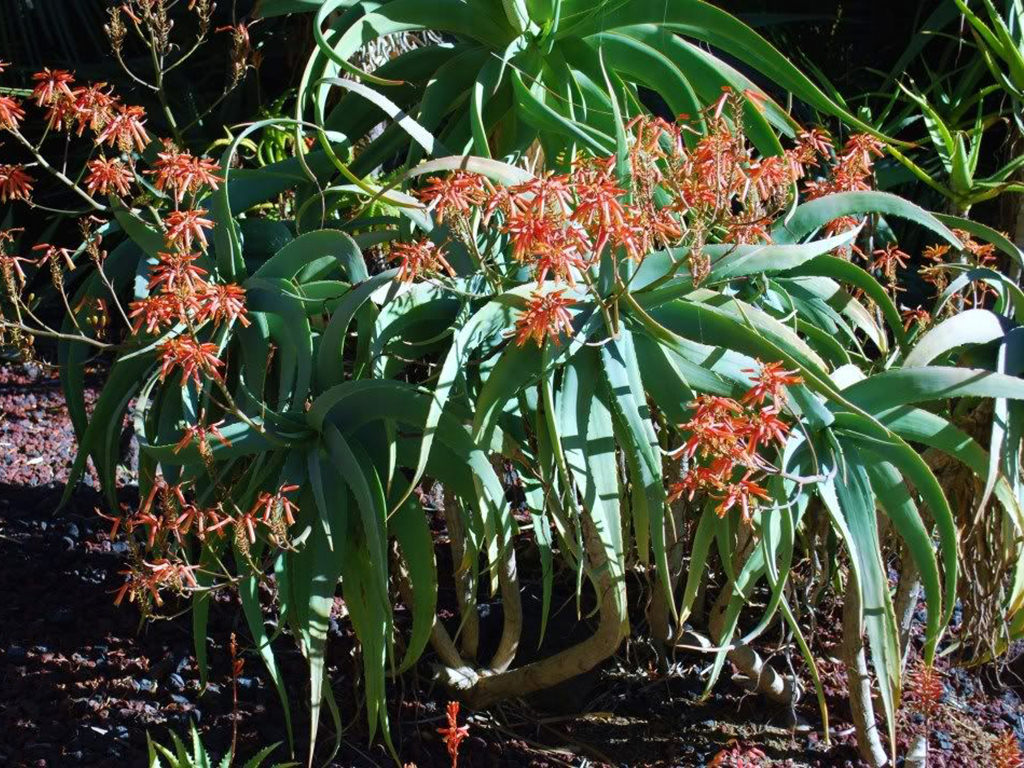Scientific Name
Aloe flexilifolia Christian
Scientific Classification
Family: Asphodelaceae
Subfamily: Asphodeloideae
Genus: Aloe
Origin
This species is native to the Usambara Mountains in northeastern Tanzania.
Description
Aloe flexilifolia is a succulent shrub with many branches that arise from the base to form a large clump. Branches can be either stout, erect, and up to 3.3 feet (1 m) tall or slender, pendulous, and up to 6.6 feet (2 m) long. Leaves are laxly crowded at the top of branches, pale bluish-green with pale brown sharp teeth along the margins and a few white spots when young. They are lance-shaped, decurved, up to 20 inches (50 cm) long, and up to 2.8 inches (7 cm) wide. Flowers are tubular, bright red or brownish red, sometimes yellow, up to 1.4 inches (3.5 cm) long and about 0.3 inches (0.8 cm) in diameter. They grow in erect, cylindrical racemes on up to 26 inches (65 cm) long stalks with 6 to 8 branches from summer to fall.
Etymology
The specific epithet "flexilifolia" derives from the Latin words "flexilis," meaning "pliant or flexible," and "folia," meaning "leaves," and refers to the leaves that are capable of bending without breaking.

How to Grow and Care for Aloe flexilifolia
Light: When growing A. flexilifolia indoors, place your plant near a window with plenty of bright indirect light. Rotate the pot once or twice a week so that all sides of the plant receive equal lighting. Outdoors, provide light shade, especially during the hottest parts of the day.
Soil: Plant A. flexilifolia in a well-drained soil mix specially formulated for succulents or make your own. Drainage is essential because too much moisture around roots can cause root rot.
Hardiness: When temperatures shift below 50 °F (10 °C), it is time to bring your plant back inside. A. flexilifolia can withstand temperatures as low as 30 to 50 °F (-1.1 to 10 °C), USDA hardiness zones 10a to 11b.
Watering: This succulent does need regular watering but is very tolerant of drought conditions for short periods. Water deeply, but only when the soil is dry. Cut back on watering during the winter months. Do not let water stand in the rosettes.
Fertilizing: A. flexilifolia generally does not require fertilizer but may benefit from the extra nutrients. Feed with a fertilizer for succulents in spring and summer only. Be sure to follow the label directions.
Repotting: This plant is not particularly fast-growing and will only rarely need repotting. Repot it in the spring in a container a few inches larger in diameter every few years to keep it from becoming rootbound.
Propagation: Propagating A. flexilifolia can be done using the offsets, cuttings, or seeds from a mature plant. Remove offsets from the mother plant or take cuttings with a sharp knife in late spring or early summer. For best results, sow seeds during the warm months.
Learn more at How to Grow and Care for Aloe.
Toxicity of Aloe flexilifolia
A. flexilifolia is not listed as toxic for people and pets.
Links
- Back to genus Aloe
- Succupedia: Browse succulents by Scientific Name, Common Name, Genus, Family, USDA Hardiness Zone, Origin, or cacti by Genus
Photo Gallery
Click on a photo to see a larger version.



